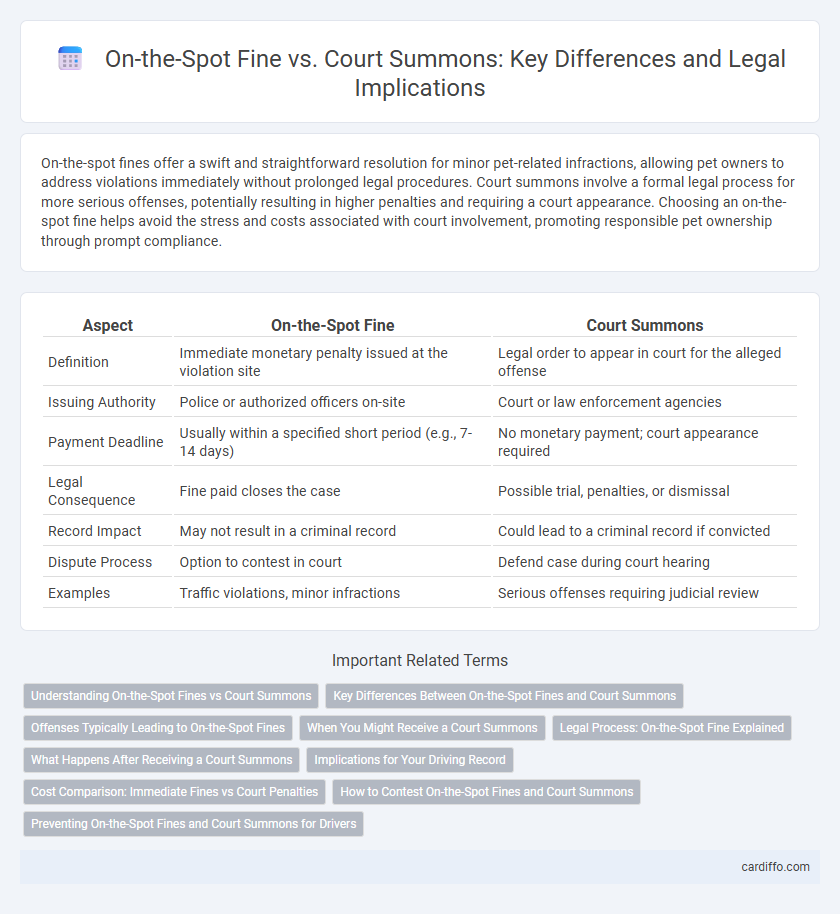On-the-spot fines offer a swift and straightforward resolution for minor pet-related infractions, allowing pet owners to address violations immediately without prolonged legal procedures. Court summons involve a formal legal process for more serious offenses, potentially resulting in higher penalties and requiring a court appearance. Choosing an on-the-spot fine helps avoid the stress and costs associated with court involvement, promoting responsible pet ownership through prompt compliance.
Table of Comparison
| Aspect | On-the-Spot Fine | Court Summons |
|---|---|---|
| Definition | Immediate monetary penalty issued at the violation site | Legal order to appear in court for the alleged offense |
| Issuing Authority | Police or authorized officers on-site | Court or law enforcement agencies |
| Payment Deadline | Usually within a specified short period (e.g., 7-14 days) | No monetary payment; court appearance required |
| Legal Consequence | Fine paid closes the case | Possible trial, penalties, or dismissal |
| Record Impact | May not result in a criminal record | Could lead to a criminal record if convicted |
| Dispute Process | Option to contest in court | Defend case during court hearing |
| Examples | Traffic violations, minor infractions | Serious offenses requiring judicial review |
Understanding On-the-Spot Fines vs Court Summons
On-the-spot fines are immediate penalties issued by law enforcement for minor offenses, allowing quick resolution without court involvement. Court summons require the accused to appear in court, typically for more serious violations where a judge determines the outcome. Understanding the differences between these processes helps individuals respond appropriately based on the severity and legal implications of the offense.
Key Differences Between On-the-Spot Fines and Court Summons
On-the-spot fines require immediate payment for minor offenses, streamlining the resolution process without court involvement. Court summons are issued for more serious or contested violations, mandating a legal hearing where evidence is presented and penalties are determined. The key difference lies in immediacy and formality: on-the-spot fines offer swift penalties, whereas court summons initiate formal judicial proceedings.
Offenses Typically Leading to On-the-Spot Fines
Offenses typically leading to on-the-spot fines include minor traffic violations such as speeding, illegal parking, and running a red light, allowing authorities to impose immediate penalties without court proceedings. These fines provide swift enforcement for infractions that do not require formal judicial review, ensuring efficient resolution of common offenses. More serious violations, like reckless driving or DUI, usually prompt a court summons due to the need for a legal hearing and potential criminal charges.
When You Might Receive a Court Summons
A court summons is typically issued when an on-the-spot fine is contested or if the alleged offense is more serious than those usually handled by immediate fines, such as repeated traffic violations or criminal matters. Authorities may issue a summons if the individual fails to pay or respond to an on-the-spot fine within the stipulated deadline, leading to further legal proceedings. Receiving a court summons means the matter will be adjudicated in a formal court setting, often involving a hearing date and the opportunity to present a defense.
Legal Process: On-the-Spot Fine Explained
An on-the-spot fine allows law enforcement officers to immediately issue and collect a penalty for minor infractions without requiring a court appearance, streamlining the legal process. This fine serves as an expedited resolution method, reducing administrative burden and ensuring prompt compliance with regulations. Unlike a court summons, which mandates a legal hearing and potential trial, the on-the-spot fine offers a swift and straightforward enforcement mechanism.
What Happens After Receiving a Court Summons
After receiving a court summons, the individual must appear in court on the specified date to respond to the charges. Failure to attend can result in a warrant for arrest or additional penalties. The court will review the case, hear evidence, and determine the appropriate fine or legal action based on the violation.
Implications for Your Driving Record
Receiving an on-the-spot fine typically results in an immediate penalty but often does not affect your driving record as severely as a court summons. A court summons can lead to a formal hearing, increasing the risk of points added to your license or higher fines if found guilty. The presence of points on your driving record impacts insurance premiums and driving privileges over time.
Cost Comparison: Immediate Fines vs Court Penalties
On-the-spot fines typically involve a fixed amount payable immediately, reducing administrative costs and avoiding court fees. Court summons penalties often result in higher total expenses, including legal fees, court costs, and potential increased fines if found guilty. Choosing an immediate fine can be more cost-effective by eliminating prolonged legal procedures and additional charges.
How to Contest On-the-Spot Fines and Court Summons
To contest an on-the-spot fine, promptly gather evidence such as photos or witness statements and submit a written appeal to the issuing authority within the specified timeframe, often 7 to 14 days. For a court summons, it is essential to appear on the scheduled date and present your defense, supported by documented proof and legal counsel if possible. Both processes require strict adherence to deadlines and clear communication to increase the chances of a successful challenge.
Preventing On-the-Spot Fines and Court Summons for Drivers
Preventing on-the-spot fines and court summons for drivers relies heavily on adhering to traffic regulations such as speed limits, seatbelt use, and avoiding mobile phone distractions while driving. Regular vehicle maintenance and ensuring all documents like insurance and registration are up to date also reduce the risk of penalties. Drivers should stay informed about local traffic laws and use defensive driving techniques to minimize violations and legal consequences.
On-the-spot fine vs Court summons Infographic

 cardiffo.com
cardiffo.com